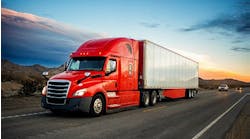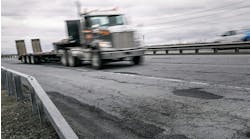“It’s what’s on the inside that counts.”
The adage is seemingly as old as time, but what we don’t always hear is the story of how we got “what’s on the inside.” In the trucking industry, so many moving parts come together to power a safe and productive fleet, and they all need to fit together. Arguably, nowhere is the fit more important than with the steer axle kingpin kit.
Drake Piper, sales manager for Kaiser, GAFF and Equipment, and Alejandro Ayala, senior product manager for Kaiser Products, both from Stemco, talk about why kingpin kits are so important, what to look for, and how to maintain them. They also explain how one of today’s most popular bushings — the spiral steel bushing — came to be and why the industry didn’t accept it right away.
What are kingpins and what purpose do they serve on commercial trucks? What kinds of kingpin kits are there?
Alejandro Ayala: The main role of a kingpin is to maintain the steering geometry of the alignment of the truck. It is a combined bearing system that supports the loads of the axle and allows the steering of the vehicle. In today’s market, there are several options for kingpin kits. The main component that most shops think about when determining which kit to purchase is the bushing type included in the kit. There are many different kingpin kits on the market including nylon, bronze, bi-metal, composite, and the spiral steel bushing.
Specifically, what is the spiral steel bushing and how is it unique?
Ayala: This component in the kit is key for the durability of a kingpin repair. The softer the material, or if the materials are not proper for the loads, the more prone the components are to reduced life and repeated repairs, adding maintenance costs. This can lead to higher fuel costs, downtime, and excessive wear on tires. This is where the spiral steel bushing shines: in providing low cost-per-mile for fleets.
What is the story behind the development of the spiral steel bushing?
Drake Piper: Back in the 1960s, Kaiser was a company making spiral steel bushings [which were used as drill press bushings] for the “Big Three” [automakers] in the Detroit area. There was a milkman who was having a lot of problems with his kingpins on his milk truck. He stopped in [to Kaiser] and said, “I need some help.” And that’s where [his] inventive mind came into play, saying, “Can this steel bushing be used as a kingpin bushing?”
The updated bushing design for kingpins was adapted, worked, and later presented to a fleet called Consolidated Freightways [who installed the spiral steel bushings] on its vehicles. After six months, they said, “These things work great, they grease great, and they last a lot longer.”
How was the product received in the industry? How did the perception change over time? Why do you think it changed?
Piper: For the first 25 or 30 years, [the spiral steel bushing] was primarily used on school buses, the Consolidated Freightways fleet vehicles, and a few other vehicles around the country. It was something so different. It was metal on metal; the thought was that it would ruin the spindle.
Ayala: As we worked to expand usage, customers were reluctant to try the bushing, thinking that since it was a steel bushing, it would weld and ruin the axle.
Piper: However, as customers came around and gave it a try, they found that the Kaiser spiral steel bushing lasted longer — a lot longer than a normal kingpin kit. In fact, they lasted about four times longer than kits without a spiral steel bushing. The other great thing that customers appreciated was that they could do the repairs themselves instead of sending the bushing out to a machine shop to get repaired. The steel bushing allowed the user to just twist the component in and be done with it, and that’s what made it attractive.
As more customer stories came out, people heard the stories and decided to give the spiral steel bushing a try for themselves. Over time, more and more customers found that the Kaiser kingpin kits with the spiral steel bushing provided significantly more life than kits equipped with other bushing material.
What are the characteristics of a high-quality kingpin kit?
Ayala: The bushing selected should be the one that’s going to last longer in the application. For the overall kit, the quality of the components also adds a lot of value to the durability of the kit. For example, the lip seal in the kingpin kit is a small component but avoiding contamination in the spindle can save thousands of dollars in the long run.
What advice would you give to fleets who are sourcing kingpins for their vehicles?
Piper: If you want to do a great kingpin repair, look at the axle bore, make sure it’s up to factory minimum/maximum specifications, and install a quality kingpin. Then you’re going to drive past your next three kingpin repairs. The fit is important, the finish is important, and it’s how all the material mates together. Even if you have a quality kingpin in there, it won’t matter if the fit isn’t right.
Ayala: Find a quality supplier that is a recognized brand in the market. Then, select the bushing type that is going to keep your cost per mile the lowest. It’s not about the cost of the kit itself, it’s about how much maintenance cost the kit is going to save you over the life of the components. Make sure to do the fit test when installing the bushings, because if there is a side load on the spindle knuckle, those bushings will also wear prematurely. And, always lubricate during the installation and maintenance. The more lubrication you have between the pin and the bushing, the longer the kit will last. If you’re looking for more information about how to perform a quality kingpin replacement, follow the maintenance practices in the Technology & Maintenance Council Recommended Practice 651.
The spiral steel bushing took time to catch on, but when it did, the fit was right for the industry.



